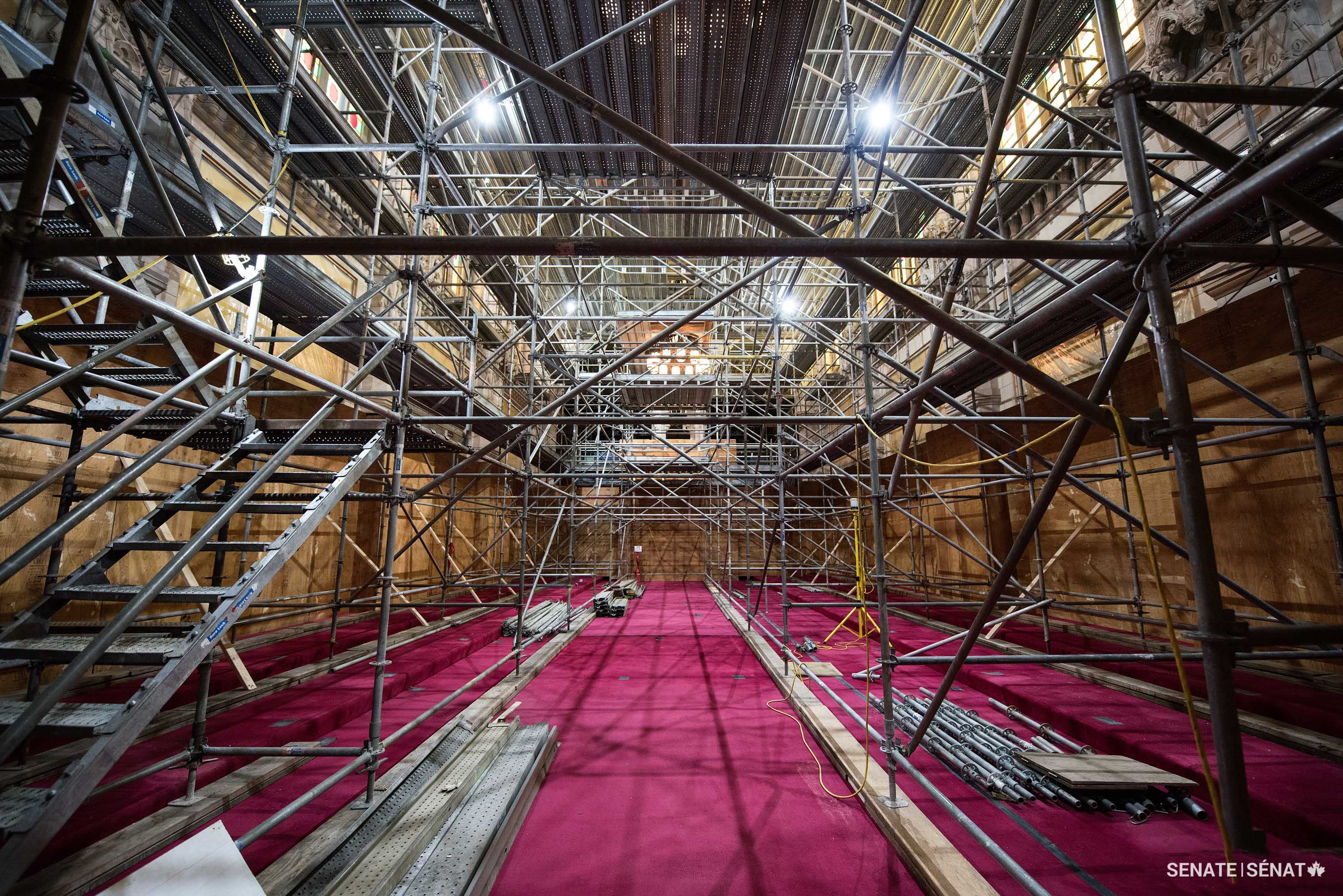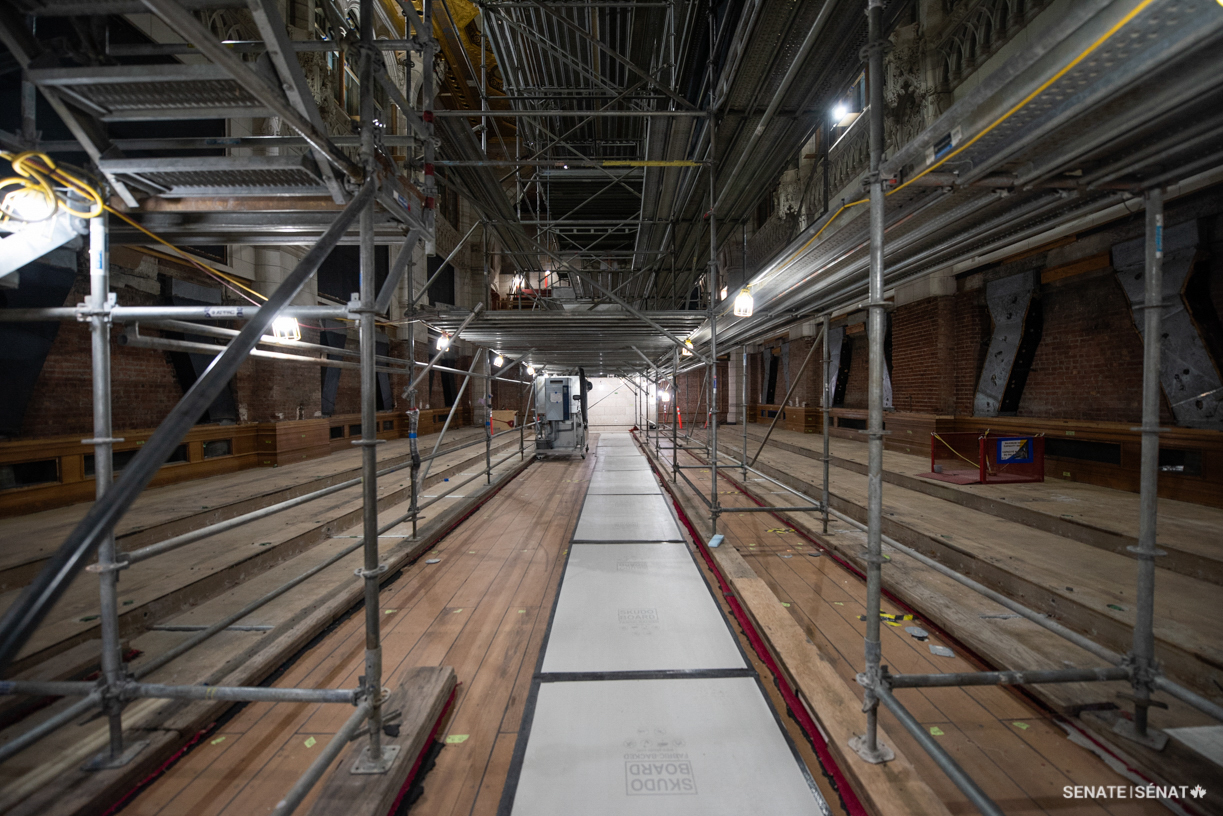Anatomy of a Senate Chamber: Taking stock of restoration work in Centre Block’s Upper House

In February 2019, the Senate moved to the Senate of Canada Building, a former train station built in 1912. The Senate will occupy this temporary location while Parliament’s Centre Block — the Senate’s permanent home — is rehabilitated.
Although Centre Block is shuttered for rehabilitation work, Canadians can still experience its art and architecture — as well as the Senate of Canada Building’s — through the Senate’s immersive virtual tours.
The Senate Chamber in Centre Block is a special place. The grand, crimson-floored room is where many Canadians see their democracy in action.
It’s the permanent home of the Upper House of Canada’s Parliament. It’s where senators debate issues and legislation of importance to Canadians, where the Speech from the Throne is read to open a new session of Parliament, and where bills receive Royal Assent.
Over the last four-and-half years, however, it’s been closed to parliamentary business while Centre Block undergoes the biggest heritage restoration project in Canada’s history. The rehabilitation will see the century-old building brought up to modern building codes and safety, accessibility and sustainability standards so it can continue to serve Canadians for decades to come — an effort overseen in part by the Senate’s Subcommittee on Long Term Vision and Plan.
The complex rehabilitation work has utterly transformed the Red Chamber; most of its special architectural and heritage features have now been removed temporarily and preserved with great care.
Check out these features about five key restoration projects in the Senate Chamber since 2019:
 Conservators take down James Kerr-Lawson’s The Cloth Hall, Ypres (1919) from the walls of the Senate Chamber in Centre Block. (CWM 19710261-0334, Beaverbrook Collection of War Art, Canadian War Museum)
Conservators take down James Kerr-Lawson’s The Cloth Hall, Ypres (1919) from the walls of the Senate Chamber in Centre Block. (CWM 19710261-0334, Beaverbrook Collection of War Art, Canadian War Museum)
1. Preserving the Past: Conservators crate up historic war paintings in the Senate Chamber
Eight monumental war paintings were carefully removed from the Senate’s permanent home in 2019 as part of Centre Block’s rehabilitation. These depictions of the First World War had hung in the Red Chamber since 1921.
Because of their age and size — more than three metres wide and two metres high — the canvases presented a particular challenge to the specialists tasked with their move.
Read the full article about the preservation of the war paintings.
 The Senate ceiling’s 40 coffers depict symbols of Canada and its European connections, including English, Irish, Scottish, Welsh and French imagery.
The Senate ceiling’s 40 coffers depict symbols of Canada and its European connections, including English, Irish, Scottish, Welsh and French imagery.
2. Gilded Glory: Revealing the appealing Senate ceiling
One of the Senate Chamber’s most magnificent (and perhaps largest) heritage features can be found in an unexpected place: at the very top of the room!
The Chamber’s ceiling is truly breathtaking: its 40 octagonal coffers depict hand-painted Canadian, English, Irish, Scottish, Welsh and French symbols — including lions, maple leaves and fleurs-de-lis. Most of the ceiling is gilded in thin, light-as-air sheets of gold that were painstakingly brushed on by hand.
The state of this 100-year-old masterpiece was assessed in 2020 so its beauty can be maintained for future generations.
Read the full article about the conservation of the coffered ceiling.
 The painted linen ceilings in the Senate’s galleries feature an understated colour palette, provincial symbols and lattice stencilling that conceals the seams between the bolts of linen.
The painted linen ceilings in the Senate’s galleries feature an understated colour palette, provincial symbols and lattice stencilling that conceals the seams between the bolts of linen.
3. A Clean Sheet: Conserving the Senate’s linen ceilings
Tucked behind the coffered ceiling was another architectural gem, often overshadowed by the gilded glory of its showier neighbour.
A painted expanse of linen floated above the Chamber’s north gallery, its subtle splendour a feat of engineering and craftsmanship. It was suspended over the gallery in several strips more than a century ago to hover over visitors and members of the press watching proceedings from the balcony above the Speaker’s chair.
Deemed too fragile to keep in place during Centre Block’s restoration, conservators removed the linen ceiling in 2020 using a similar technique they employed to remove the Chamber’s war paintings.
Read the full article about the removal of the linen ceilings.
 This undated photograph shows one of the Senate chandeliers, with its original egg-shaped lanterns, suspended close to the floor of the Red Chamber. (Photo credit: Library and Archives Canada)
This undated photograph shows one of the Senate chandeliers, with its original egg-shaped lanterns, suspended close to the floor of the Red Chamber. (Photo credit: Library and Archives Canada)
4. Bronze Beauties: Spotlighting the Senate Chamber’s two chandeliers
For nearly 100 years, two enormous bronze and cast-iron chandeliers hung from the Senate Chamber’s gilded ceiling, illuminating the room’s stunning features.
Despite being central fixtures in the Red Chamber for so long, the origins of the identical chandeliers remained a bit of a mystery — that is, until experts took a closer look and uncovered more details before they were temporarily dismantled as part of Centre Block’s rehabilitation.
Read the full article about the custom, three-tonne Senate chandeliers.
 A worker takes down one of the Senate Chamber’s 16 cherubs, made of solid white oak.
A worker takes down one of the Senate Chamber’s 16 cherubs, made of solid white oak.
5. Disassembling the woodwork in the Red Chamber and Senate Reading Room
Heritage conservators and skilled carpenters have been carefully dismantling century-old decorative woodwork in Centre Block.
This massive job has unfolded over months. It has required extensive research, meticulous cataloguing and expertise in heritage construction and conservation. The experts recruited for the task have had to solve the puzzle of how the woodwork was assembled and installed, and then work backwards.
In some cases, the woodwork’s removal has revealed some surprises from the past!
Read the full article about the dismantling of the Senate’s woodwork.
 The Senate Chamber in Centre Block, pictured before the building was closed for rehabilitation.
The Senate Chamber in Centre Block, pictured before the building was closed for rehabilitation.
 The Senate Chamber in Centre Block, pictured in December 2018.
The Senate Chamber in Centre Block, pictured in December 2018.
 The Senate Chamber in Centre Block, pictured in February 2020.
The Senate Chamber in Centre Block, pictured in February 2020.
 The Senate Chamber in Centre Block, pictured in February 2023.
The Senate Chamber in Centre Block, pictured in February 2023.


